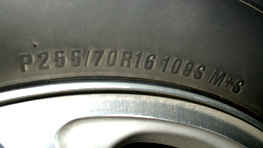
Description: Tires have a coding system all their own that indicates key things like size, application, speed rating, treadwear factors and some others. All of this information is represented through an ordered series of numbers and letters on the sidewalls of tires.
Purpose: Tires are a normal wear item and eventually you'll be faced with replacing them. When you do, making the right choices can make a big difference in your satisfaction once your new tires are installed.
Maintenance Tips/Suggestions: With a P225/75R15 tire as an example, "P" represents passenger car applications (LT=Light Truck), 225 indicates the width of the tire in millimeters, 75 represents the aspect ratio (width of the tread, divided by sidewall height), "R" means radial construction (most tires nowadays) and the 15 means the diameter of the wheel in inches. A tire may also carry a speed rating, which represents the maximum safe driving speed for a given tire. Speed ratings range from "S" to "Y", which represent 112 and 186 miles per hour respectively. (Speed-rated tires are usually used in high-performance applications.) Usually, the speed rating follows the load-carrying designation. In the picture shown above, an "S" follows the load designation, 109. Some high-performance tires, however, may have their speed-rating symbol placed in front of the "R" symbol.
In most cases, cars and minivans are originally equipped with passenger car tires, whereas larger vehicles like pickups, SUVs and the like come equipped with light-truck tires. It's important to stick with the size tires and types as recommended by your car's manufacturer or in a tire application guide from a tire maker. Using tires of the wrong size can interfere with steering and suspension parts and it can affect the accuracy of your car's speedometer along with onboard control technology such as the transmission and anti-lock brakes.
There are three other factors that may be helpful in your tire selection process. These three "T's" are treadwear, traction and temperature. As with tire sizes, the codes for these are marked on the sidewall of the tire, too. The treadwear number is a relative indicator of just that, the higher the number, the better. In theory, a treadwear index of 200 means that the tire will last twice as long as a tire with a 100 index. Next, comes the traction index, which is expressed as a letter. A tire that performs well during braking on both wet concrete and asphalt gets an "A" index; a tire that performs well on only one of the surfaces gets a "B" index; and a tire that performs poorly on both surfaces gets a "C" index. The last of the "T's" is temperature resistance. An "A" index means the tire has a high resistance to temperature; "B" means a medium temperature-resistance and a "C" index indicates that the tire meets basic safety standards.
There are still other considerations that go into formulating a tire choice that's just right for your car, based on personal preferences. This may include the type of tread for on- or off-road use, the amount of noise the tires produce when driving on paved surfaces and other appearance-related options like raised white letters or black sidewalls.

